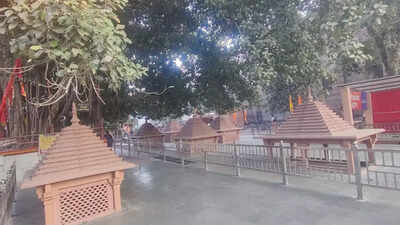- News
- Trip to ancient Akshayavat Patalpuri temple hidden beneath surface must for completion of Kumbh snan
Trip to ancient Akshayavat Patalpuri temple hidden beneath surface must for completion of Kumbh snan
The Akshayavat Patalpuri temple in Prayagraj, built during Emperor Akbar's reign, is an ancient subterranean temple adorned with statues and murals depicting Hindu mythology. Recent renovations have improved accessibility for pilgrims visiting this historic site, though parts remain under Army control.
PRAYAGRAJ: When Chinese pilgrim Hiuen-Tsang visited India during the reign of emperor Harshavardhan in AD 644, he chronicled the Allahabad Fort, presently under the jurisdiction of Army Ordnance Depot, as a magnificent fortified edifice encompassed by two rivers Ganga and Yamuna, situated in a verdant garden to the south and west of the kingdom of Po-lo-ye-Kia, now referred as Prayag city. He documented the existence of a temple including the shrine of Shiva inside the fort adjacent to a sacred banyan tree.
Read more: Maha Kumbh stories
Presently, the temple is recognised as Akshayavat Patalpuri, a subterranean temple accessed through a tunnel situated beneath an elevated mound in the centre of a courtyard. The temple connects from the west to its altar, buttressed by pillar tops fashioned in ancient temple architecture. There are seven rows of pillars, each row comprising 12 columns.
The temple houses over 40 exquisitely embellished ancient statues of deities and sages arranged systematically along the periphery. The present structure of the temple was erected by Emperor Akbar in the 16th century as part of fort construction.
Life events of all the deities and sages in the temple are illustrated through intricate murals on the exterior walls of the temple complex. In 2024, Kumbh Mela administration renovated the Akshayavat Patalpuri temple corridor for pilgrims, and illuminated the tunnel of the cavern temple which is now predominantly refurbished with red stones, and wall carvings portraying various Hindu mythological narratives.
Speaking to TOI, Hemendra Nath Yojeshwar, who was part of Akshayavat Patalpuri temple management, said, “After renovation, the Akshayavat Patalpuri temple is now more easily accessible to pilgrims who come for Sangam snan. However, the other side of the holy Akshayavat tree is still under Army jurisdiction and thereby a restricted area. Currently, pilgrims can watch the holy tree from a distance while walking through the newly developed corridor. The corridor culminates with a visit to Saraswati koop temple.”
End of Article
FOLLOW US ON SOCIAL MEDIA
Visual Stories
Hot Picks
TOP TRENDING
Explore Every Corner
Across The Globe










